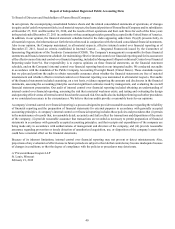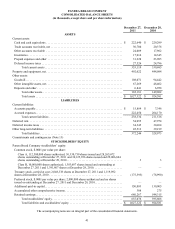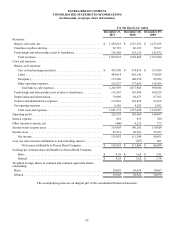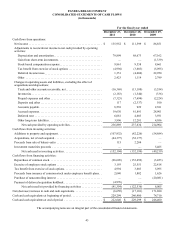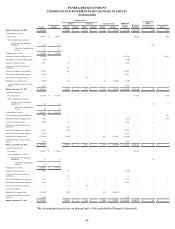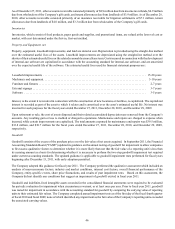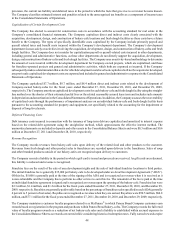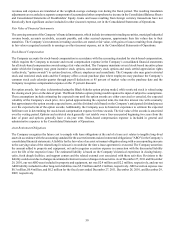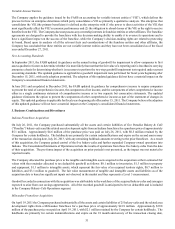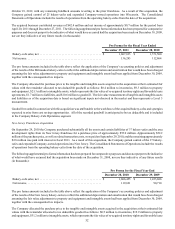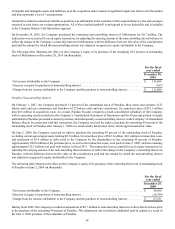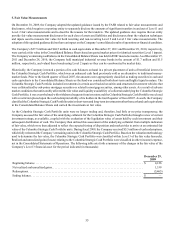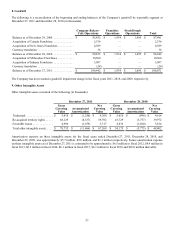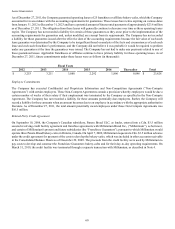Panera Bread 2011 Annual Report Download - page 58
Download and view the complete annual report
Please find page 58 of the 2011 Panera Bread annual report below. You can navigate through the pages in the report by either clicking on the pages listed below, or by using the keyword search tool below to find specific information within the annual report.50
revenues and expenses are translated at the weighted-average exchange rate during the fiscal period. The resulting translation
adjustments are recorded as a separate component of accumulated other comprehensive income in the Consolidated Balance Sheets
and Consolidated Statements of Stockholders’ Equity. Gains and losses resulting from foreign currency transactions have not
historically been significant and are included in other (income) expense, net in the Consolidated Statements of Operations.
Fair Value of Financial Instruments
The carrying amounts of the Company’s financial instruments, which include investments in trading securities, municipal industrial
revenue bonds, accounts receivable, accounts payable, and other accrued expenses, approximate their fair values due to their
maturities. The Company’s investments in trading securities are stated at fair value, with gains or losses resulting from changes
in fair value recognized currently in earnings as other (income) expense, net in the Consolidated Statements of Operations.
Stock-Based Compensation
The Company accounts for stock-based compensation in accordance with the accounting standard for stock-based compensation,
which requires the Company to measure and record compensation expense in the Company’s consolidated financial statements
for all stock-based compensation awards using a fair value method. The Company maintains several stock-based incentive plans
under which the Company may grant incentive stock options, non-statutory stock options and stock settled appreciation rights
(collectively, “option awards”) to certain directors, officers, employees and consultants. The Company also may grant restricted
stock and restricted stock units and the Company offers a stock purchase plan where employees may purchase the Company’s
common stock each calendar quarter through payroll deductions at 85 percent of market value on the purchase date and the
Company recognizes compensation expense on the 15 percent discount.
For option awards, fair value is determined using the Black-Scholes option pricing model, while restricted stock is valued using
the closing stock price on the date of grant. The Black-Scholes option pricing model requires the input of subjective assumptions.
These assumptions include estimating the expected term until the option awards are either exercised or canceled, the expected
volatility of the Company’s stock price, for a period approximating the expected term, the risk-free interest rate with a maturity
that approximates the option awards expected term, and the dividend yield based on the Company’s anticipated dividend payout
over the expected term of the option awards. Additionally, the Company uses its historical experience to estimate the expected
forfeiture rate in determining the stock-based compensation expense for these awards. The fair value of the awards is amortized
over the vesting period. Options and restricted stock generally vest ratably over a four-year period beginning two years from the
date of grant and options generally have a six-year term. Stock-based compensation expense is included in general and
administrative expenses in the Consolidated Statements of Operations.
Asset Retirement Obligations
The Company recognizes the future cost to comply with lease obligations at the end of a lease as it relates to tangible long-lived
assets in accordance with the accounting standard for the asset retirement and environmental obligations ("ARO") in the Company’s
consolidated financial statements. A liability for the fair value of an asset retirement obligation along with a corresponding increase
to the carrying value of the related long-lived asset is recorded at the time a lease agreement is executed. The Company amortizes
the amount added to property and equipment, net and recognizes accretion expense in connection with the discounted liability
over the life of the respective lease. The estimated liability is based on the Company’s historical experience in closing bakery-
cafes, fresh dough facilities, and support centers and the related external cost associated with these activities. Revisions to the
liability could occur due to changes in estimated retirement costs or changes in lease terms. As of December 27, 2011 and December
28, 2010, our net ARO asset included in property and equipment, net was $2.4 million and $2.2 million, respectively, and our net
ARO liability included in other long-term liabilities was $5.9 million and $5.2 million, respectively. ARO accretion expense was
$0.3 million, $0.4 million, and $0.2 million for the fiscal years ended December 27, 2011, December 28, 2010, and December 29,
2009, respectively.


